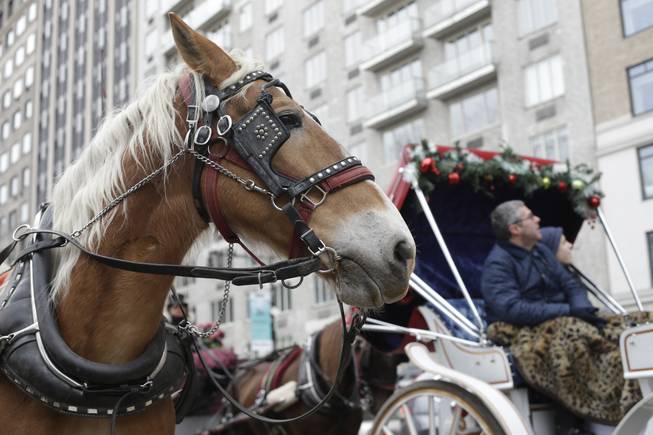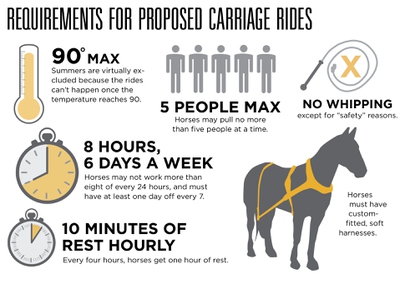
Frank Franklin II / AP
Passengers enjoy a horse-drawn carriage ride near Central Park on New Year’s Eve day, Tuesday, Dec. 31, 2013, in New York.
Sunday, March 30, 2014 | 2 a.m.
Dozens of cities still let them clop and roll down urban streets, but growing concern for animal welfare is casting aspersions on the tourist-driven horse-drawn carriage trade.
In New York City, whose Central Park carriages are known the world over, the time for the age-old attraction is passing. During his successful campaign for NYC mayor, Bill de Blasio called horse carriages “not humane” and “not appropriate to the year 2014; it’s over.”
Well, Las Vegas isn’t New York, even if some of our city’s early investors and/or knuckle-breakers hail from there. So even as NYC prepares a ban, the Las Vegas City Council appears on the verge of approving routes for downtown carriage rides.
To those who have lived through Las Vegas’ desert heat, the city’s consideration evokes an obvious question: horse-drawn carriages in the desert?
“I would urge the city council to ... make it humane or there (will be) issues,” said Valerie Pringle, equine protection specialist for the U.S. Humane Society. She lives in Maryland. She also owns a draft horse, the type of animal typically harnessed to pull a carriage.
“It’s weird that it comes at a time when New York is considering a ban,” Pringle added. “There are lots of issues for people and for horses.”
Yet carriage rides are nothing new to Las Vegas. Neither is controversy over them. In the early 2000s, the Rev. Stephen Smith and Robert Humpherys worked five years to gain city approval of an ordinance that allowed carriage operations downtown.
Approval came in late 2007 after a council flip-flop: First it allowed the rides, but only if carriages had seat belts and the horses had been acclimated to traffic noise. Later, those requirements were dropped. The argument against seat belts was that insurance companies didn’t like them as they made the rides more dangerous — if a horse got spooked, the passengers wouldn’t be able to quickly jump out — Smith said at the time.
Smith looks back on it as a good business that will do very well in redeveloping downtown.
“It will work — and it will work big-time,” he said.
He got out of the business after Humpherys died in 2012. It was tough to give up the business, given that he put in so much time gaining city approval. In the early 2000s, Smith said, council members were skittish because of a horse-carriage accident years earlier.
In February 1985, four people in a carriage were injured when thrown from a carriage after a horse got spooked and ran across six lanes on the Vegas Strip. Connecticut tourist Laurette Dragon, 53, suffered severe head injuries. The Nevada Public Service Commission then banned the rides on the Strip and in downtown.
Smith said the ban prevented him from operating rides between Bridger and Stewart avenues, and from 7th to Main streets.
The new proposed route allows rides within that area but takes away the major thoroughfares of Fremont Street and Las Vegas Boulevard. Except on weekends, routes are also restricted from 3 p.m. to 6 p.m. on Main and 4th streets, and on Stewart Avenue between 4th and 6th streets.
The city also has a raft of rules to follow, even though passenger seat belts and a measure of a horse’s ability to keep its cool in a noisy, angry city milieu no longer exist.
One provision of the code says no animal “may be subjected to any condition or treatment which will impair the good health or physical condition of the animal.”
To some people, simply having a horse tromp around on asphalt all day is poor treatment.
“I would never work a horse on the asphalt for eight, nine hours a day,” Pringle said. “Their feet ... are not meant to work on asphalt.”
If Las Vegas approves new routes and somehow circumvents the ban ordered by the state public services commission, Pringle is fairly sure the same things that helped derail carriage rides in New York City will be at work in Las Vegas: a generational shift in concerns for animals and cellphones.
“People these days pick up the phone and call, or they can document (what they see) with a date-stamped photo,” Pringle said. “And people are much more aware of animal welfare.”
A possible vote on the routes is scheduled for April 16.


Join the Discussion:
Check this out for a full explanation of our conversion to the LiveFyre commenting system and instructions on how to sign up for an account.
Full comments policy